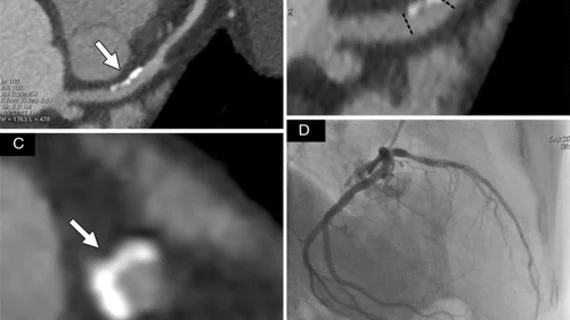Patients with normal arteries upon coronary CT angiography (CTA) experienced either death or myocardial infarction at a rate of 0.04 percent per year, according to a study with 10 years of follow-up published in JACC: Cardiovascular Imaging.
The results demonstrate CTA findings may help reclassify a significant proportion of patients from an intermediate cardiac risk category to a low-risk group. Based on a clinical risk model—the Morise score—74 percent of patients in this 2,011-person cohort would be classified as intermediate risk, while 20 percent would be classified as low risk and 6 percent would be high risk.
But after coronary artery disease (CAD) severity was assessed via CTA, 83 percent of patients ended up in the low-risk category. Fifteen percent were considered intermediate risk and 2 percent were high risk. Overall, adding CTA findings shuffled 68 percent of patients to a different risk category and resulted in improved prediction for the combined endpoint of cardiac death or MI (c-statistic of 0.704 versus 0.622 for the Morise score alone).
“Patients with normal coronary CTA results benefitted from an event-free survival period of 10 years against cardiac death and nonfatal myocardial infarction,” wrote Tom Finck, MD, and colleagues, whose study population originated from a single center in Munich. “Risk stratification according to coronary CTA results allowed for the delineation of clearly diverging prognostic groups and reclassified approximately two-thirds of all patients from clinical risk groups.”
The patients were 59 years old on average and 66 percent were men. CAD severity upon CTA was assessed as either normal, nonobstructive or obstructive, with the latter category broken down by whether one, two or three vessels were found to be obstructed.
The highest risk-category—three-vessel obstructive CAD—experienced the primary outcome of cardiac death or MI at an annual rate of 1.33 percent. Finck et al. defined event-free survival as the number of years it took a patient to cumulatively reach a 1 percent probability of that composite endpoint, and they noted a significant difference in that area even for nonobstructive versus no CAD.
“Event-free survival for all investigated patients aged younger than 60 years with normal coronary arteries reached the full observation length of 10 years, independent of clinical risk, age, sex or presence of diabetes,” they wrote. “In contrast, the overall event-free survival for patients with obstructive or nonobstructive stenoses fell to 2.2 years, and fell further to 1.4 years in patients with diabetes.”
The authors noted this study had the longest follow-up of any investigation into the prognostic implications of CTA; the longest previous one had a follow-up of 7.8 years. Longer monitoring is particularly important for CAD given its slow-developing nature, they wrote, which may make CTA a better predictor of long-term outcomes than functional assessments of stenosis.
“The shorter event-free survival periods for functional image testing was easily explained by the fact that it relied on hemodynamically relevant coronary stenoses typical for a more progressive stage of CAD,” Finck and coauthors wrote. “By not only assessing obstructive coronary stenosis but also subtle coronary changes in earlier stages of CAD, coronary CTA can assess the whole range of coronary artery changes.
“This, and the high negative predictive value during a 10-year follow-up period as shown in this study, emphasized the particular usefulness of this modality in the low to intermediate pre-test risk population.”
The authors of an accompanying editorial pointed out it’s been difficult to study low-risk CAD cohorts because of low event rates, which necessitate a larger sample size, longer follow-up or both to detect enough events to achieve statistical power. This study was more revealing, they said, “because when you observe a patient from middle-age to elderly for a decade or longer, this provides a closer approximation to their life expectancy.”
“One may speculate based on this report and those from other CTA registries that anatomic findings more profoundly stratify risk groups than functional measurements,” wrote Leslee J. Shaw, PhD, and Subhi J. Al’Aref, MD, both with Weill Cornell Medical College in New York. “This does not call into question the prognostic importance of ischemia and other stress imaging markers but does question whether anatomy should be the core component of all risk assessment strategies.”

